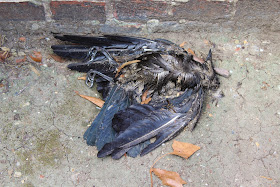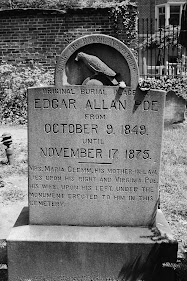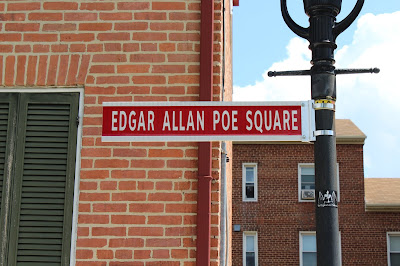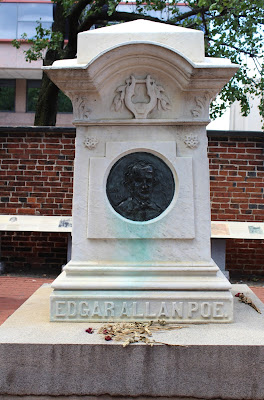I have always been fascinated by what drove certain authors
to write what they did, or where they were living at the time of writing such
great works. I have toured a few famous authors’
homes or “chased an author” as I call it, including Washington Irving’s Sunnyside in New York .
And we recently started a book club and along with reading books from all different genres, we also sometimes take field trips related to the current book we're reading.
For August we read two tales and one poem by Edgar Allan
Poe (or more if we were so inclined). I grew up on Poe and loved his stories of lost love, terror, suspense, and horror.
A few of us in the book club, The Bookworms Literary Guild, decided
to take a trip to Baltimore ,
Maryland
Baltimore has been in the news lately concerning
riots and is listed on a few websites as being in the top 10 most violent
cities. But we also found it to be a beautiful city full of culture, historical
buildings and sites, harbors, ethnic neighborhoods, churches, restaurants,
statues, and many parks. My nephew
Anthony lives and works in Baltimore
as a luxury yacht builder and assured us it’s a safe city in most areas and
that we would love it. We did.
Edgar Allan Poe
Poe was born in Boston in 1809 but grew up in Richmond , Virginia, and attended the University of Virginia
After funding was cut off from his foster father Poe dropped out of college. Later he also was expelled from West Point, so took a job as an editor at
the Southern Literary Messenger in Richmond . His controversial fiction and
scathing book reviews boosted the magazine’s circulation seven times in
seventeen months.
After termination as an editor, Poe took a series of editorial positions at the leading magazines in
In later years, during a lecture tour of the east coast, Poe engaged himself to a former childhood sweetheart (by then a wealthy
widow) Elmira Royster Shelton in Richmond, but he died while passing
through Baltimore on October 7, 1849—just ten days before the wedding. The
cause of his death remains a mystery
Listed below are the sites we chose to visit while in Baltimore
and really all we had time for. We really enjoyed the city and I would love to plan another trip.
The Edgar Allan Poe
Statue
We started our tour of Poe sites in the morning at the University of Baltimore ’s
Law School Wyman
Park around Wyman Park
was so isolated, it was decided to move the statue to the plaza of the Law School
It’s an amazing statue. The American sculptor, Sir Moses
Jacob Ezekiel envisioned Poe seated in a classical chair, adorned with images
of the muses of music and poetry. Poe’s head is tilted slightly to one side,
with his left hand raised as he listens to ethereal music. The original statue
has a large base with many inscriptions.
When the statue was moved, the base was too deteriorated so it’s now
preserved by the University
of Baltimore
The Raven
Once upon a midnight dreary, while I pondered weak and weary,
Over many a quaint and curious volume of forgotten lore,
While I nodded, nearly napping, suddenly there came a tapping,
As of someone gently rapping, rapping at my chamber door.
~Edgar Allan Poe
The Enoch Pratt Free Library
Our next stop was The Enoch Pratt Free Library which is a
public library at 400 Cathedral
Street and is one of the oldest free public
library systems in the United
States .
Besides having a beautiful atrium
and tons of books, they also have a collection of Poe memorabilia and rare books,
manuscripts, original letters, photos, articles, and even a lock of Poe’s hair
and a piece of his original wooden coffin.
A special meeting room, The Edgar Allan Poe Room on the second floor has
been dedicated to him. This is where one of the Librarians’, Michael, met with us,
bringing with him a large box full of priceless Poe items. It brought tears to the eyes to actually see
Poe’s handwriting, signature, and the lock of Poe’s hair. Most of the items the
library has were gifted to them by Poe's family members.
 |
| Photo from the Enoch Pratt Free Library website page |
 |
| We were allowed to view a few of Poe's letters, writings, and misc. items while at the Library. |
The Baltimore
Here we detoured from our Poe sightseeing because directly across the
street from the Enoch Pratt Free Library is the Baltimore Basilica. You don’t have to be religious or Catholic to
appreciate the great architecture or a beautiful historic building, and this is
one. The historic Baltimore Basilica,
built from 1806-1821 and declared a National Landmark in 1972, was the first
great metropolitan cathedral constructed in the United States after the adoption of
the Constitution.
Two prominent Americans guided the Basilica’s design and
architecture: John Carroll, the country’s first bishop, later Archbishop of
Baltimore, and cousin of Charles Carroll, a signer of the Declaration of
Independence; and Benjamin Henry Latrobe, father of American architecture, and
Thomas Jefferson’s Architect of the Washington D.C. Capitol building.
The Basilica, which culminated in years of architectural refinement by Latrobe, is now considered one of the world’s finest examples of 19th-century architecture. In 2001, under the leadership of Cardinal William H. Keeler the entire church and even the domes, (which were covered years ago and remained covered because of damage and decay), were restored.
The Basilica is a breathtaking creation with soaring ceilings, multiple domes, ceiling paintings reminisce of old European art, and a lower level full of catacomb style construction with arches, twists and turns, and vaults (or crypts) for the final resting place of Cardinals and Archbishops.
One highlight of the tour was to sit on the very same pew where the Blessed Mother Teresa ofCalcutta prayed.
One highlight of the tour was to sit on the very same pew where the Blessed Mother Teresa of
Unfortunately, this museum is only open on weekends, and
because our trip was in the middle of the week we were unable to go inside. There
is a fee to take the tour. Located at 203 N. Amity Street Baltimore
in October 2011, which ultimately led to the museum closing to the public in
2012. In October 2013 the Poe House and Museum were reopened
by a newly created non-profit organization, Poe Baltimore.
In the 1930s, homes in the area, including Poe's, were set
for demolition to make room for the "Poe Homes" a public housing project. The rows of government-funded public housing
were built, but the Poe house was spared and control was given to the Edgar Allan Poe Society of Baltimore, which opened the home as The Baltimore Poe House in 1949.
The little house (originally No. 3 Amity) was built around 1830 for Charles Klassen. Late in 1832 or early in 1833, Maria Clemm (Poe's aunt) moved from
Maria Clemm rented the house primarily with money
from her mother’s government pension. Edgar
Allan Poe left this house in August or September of 1835, moving to Richmond , Virginia
In 1979 during the house renovations, workers lifted the
floorboards and found skeletal remains, reminiscent of Poe's story "The Tell-Tale Heart." These were found to be animal bones discarded
into what is known as a "trash pit" or midden beneath the home.
The self-guided tour of the house includes
exhibits on Poe’s foster parents, his life and death in Baltimore ,
and poems and short stories written in Baltimore
 |
| The Poe house was the only building saved from demolition before a housing project was built around it. |
Before leaving for our trip, I read online that the Poe house is in a less than desirable
neighborhood. We however had no trouble
while walking around the house and even talked to area residents. The parking
was directly in front of the house.
It is always good to be aware of your surroundings where ever you go and to visit historical sites during daylight hours and in groups. But really that’s a good rule while visiting any place these days. Again, we had no problems anywhere we traveled inBaltimore . Another good idea is to not leave anything visible in
your car for thieves to want to steal, but I follow that rule even while
grocery shopping in my own neighborhood.
It is always good to be aware of your surroundings where ever you go and to visit historical sites during daylight hours and in groups. But really that’s a good rule while visiting any place these days. Again, we had no problems anywhere we traveled in
 |
| Marker on Poe's old gravesite |
Westminster Hall and Burying Grounds
The "Westminster Hall and BuryingGround" is a former Church and graveyard located at
site of Edgar Allan Poe. The complex was declared a national historic district in 1974. Edgar Allan Poe was buried here in October 1849, following his sudden and mysterious death after being found on the street near
In July 1852, a substantial church was erected over much of the
burying grounds, built upon supporting brick and stone arches or stilts to
preserve the resting places of those interred below.
Because of Poe’s subsequent growing literary fame and
acclaim as the 19th Century progressed following his unfortunate death, a
resolution was created and fundraisers started for the erection of a new monument
over Poe’s grave. Numerous activities
were held for some time by the pupils and the teachers of the Baltimore City
Public Schools, one of which was called Pennies for Poe. Even today it is tradition to leave a penny
on Poe’s grave marker.
 |
| The raven and quote from the stone on Poe's first grave. He has been moved to a location near the gate. |
Poe’s old marker, inscribed with a quote from The Raven is
in the back of the graveyard and in my opinion the better of the two markers. Other Poe family members are also buried in the
graveyard, including Poe’s grandfather General David Poe Sr. and his brother Henry
Leonard Poe
The new monument was carved by local sculptor and stonemason
Hugh Sisson, with the body of Poe exhumed and moved to the new more prominent
location near the cemetery entrance gates, and was dedicated November 17, 1875
in the presence of a large concourse of spectators. Poe’s aunt and
mother-in-law Maria Clemm and Poe's wife Virginia are also buried with Poe
at the new location.
On our visit to Poe’s grave, there was a dead black raven near the new Poe monument which was creepy but at the same time
fitting. But it also makes me wonder how many dead ravens are found each year. Poe did not kill the raven in the poem.......
 |
| Pennies for Poe was a fundraiser and leaving a penny has now become a tradition. Here's my penny left at Poe's grave |
 |
| Dead raven next to Poe's new grave marker |
The boundaries which divide life and death are at best shadowy and vague.
Who shall say where the one ends, and the other begins?
~Edgar Allan Poe
We had a sack lunch in the cemetery along with our Bookworms Literary Guild book club meeting and Poe book discussion. It’s a very small walled cemetery with large mature trees and very old graves and large vaults.
As a side note, I discover that Poe’s birthday and my husband Bill’s are the same, January 19th, both Capricorns.
Wow, this is a beautiful area and the library is like
something out of a movie! We were
speechless when we walked into the huge atrium, open on all sides to 5 stories
of books.
The George Peabody Library, located at 17
E. Mount Vernon Place , which opened in 1878, was designed by Baltimore architect Edmund G. Lind. Known as a “cathedral of books,” the
five-story reading room is consistently listed among the world’s most beautiful
libraries. Its gilded framework of cast iron and gold showcases over 300,000
volumes in the areas of archaeology, architecture, history, literature, travel,
and art.
It also houses some rare Poe books and a number of original
letters he wrote to novelist and politician John P. Kennedy as well as a large
collection of musical settings for Poe’s writings. But in order to view these documents, you must
make a request ahead of time as they need to be looked up and pulled from the
archives.
The rest of the building is private or only open for events, so we only toured the library area.
Mount Vernon Square
Mount Vernon is a neighborhood located just to the north of downtown Baltimore , and well worth the stop. Designated a National Landmark Historic District and a city Cultural District, it is one of the city's oldest neighborhoods and originally was home to the city's most wealthy and fashionable families.
This square was not on our list but we happened upon it by accident while touring the George Peabody Library, which is in the area. What great luck that was!
 |
| Diagram from a tourist brochure |
John Eager Howard donated the highest point in Baltimore for the site of the Washington Monument Washington Monument Mount Vernon Square is generally regarded as one of the most beautiful urban sites in the world. The monument, constructed of marble from three quarries in Baltimore County , Maryland Washington is depicted on the top of the Monument. John Eager Howard died in 1827 before the monument was complete. It was his heirs who laid out the park blocks, in the form of a cross.
Mount Vernon is home to some of the most historically significant and well-preserved 19th-century architecture located on the East Coast of the United States . The centerpiece of the neighborhood is the area around the Washington Monument
 |
| Vintage photo, taken by Robert F. Kniesche, the Baltimore Sun |
On the northeast corner of Washington 's monument sits the Mount Vernon United Methodist Church
The Old Church Home and
Hospital
We did not visit this site but it’s where Poe was taken and
died the night he was found unresponsive and not wearing his own clothing.
The original building is still standing. A new 166 unit townhouse development known as "Broadway Overlook" was built in 2005 by the Housing Authority of Baltimore City on the old grounds of the hospital surrounding it on the south, west, and north sides associated with J.H.H. The Old Church Home and Hospital remains and is part of the complex.
 |
| An old postcard of The Church Home and Hospital |
 |
| The layout of the apartments built around the hospital. |
Fell’s Point:
Our final stop of the Poe sites was Fell’s Point, which was established during the Colonial era. It was named for the Englishmen who founded a ship-building company here in 1726 that would go on to produce the famous "Baltimore Schooners
 |
| Old photo of Fell's Point with the Washington Monument in the background |
As for Poe connections, before living with his aunt at 203
N. Amity Street, Edgar Allan Poe lived in what was known as Mechanic’s Row, in
a house and alleyway in the Fell’s Point area, but those buildings no longer
exist. His brother, William Henry
Leonard Poe also died here in 1831. Fell’s Point is where Poe was found nearly
unconscious in a local tavern, which at the time, was converted for
voting. The tavern, known as Ryan’s
Fourth Ward Polls and later as Gunner’s Hall has long since been swallowed up
by development.
Nothing remains in this area from Poe’s time but it is a
beautiful area with waterfront loft apartments, harbor-side restaurants, shops, a waterfront park, and a walking trail. Rumor has it that Poe’s ghost still
haunts the area.
We had dinner with my nephew Anthony at the Dock Side, located
at 3301 Boston Street .
It’s a wonderful family-owned restaurant, famous for its crabs and Maryland seafood. I had their Maryland
crab cakes dinner, made with jumbo lump crab meat, broiled & lightly
seasoned with Old
Bay Virginia .
This is one of my favorite author-related road trips, second only to my Washington Irving and Sleepy Hollow, New York visit. I'm sure this would be a great fall trip during the peak leaf season and fall would be beautiful around Baltimore along with the cool breezes blowing in from the harbor.
I think I'll talk my husband into a little weekend get-away,
Elizabeth
Other Posts:


















Thanks for a marvelous posting on Poe, one of my favorite authors! I really enjoyed reading it. I will make sure to bookmark your blog and come back soon. Please continue your author trip writings! Melissa
ReplyDeleteI love Poe too, glad you liked the post, thanks for the comment.
ReplyDeleteHello There. I found your blog using a google search. That is a neatly written article. Thank you for the post.
ReplyDeleteAnnie
Thanks Annie
ReplyDeleteThanks for sharing this impressive piece of travel writing, I have wanted to tour Poe sites for years and this has motivated me! Looks like a great trip you had!
ReplyDeleteYou're very welcome, hope you finally get a chance to see Baltimore and the Edgar Allan Poe sites!
ReplyDelete